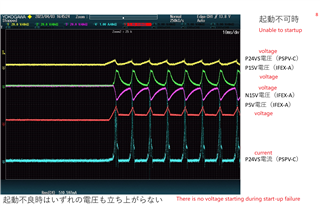Other Parts Discussed in Thread: LM60430,
Hi Team,
For section 8.2 application information of TPS65131RGER in the datasheet,

The VIN input has R7 (100ohm) and C3 (100nF) (the time constant is 10us),
When I measured in the test, the power supply turned on without load.
When testing with load, the power supply did not start up, so R7 was changed to 100kohm and the time constant was changed to 10ms.
However, the power supply did not start up both with load and without load.
I think it will not start because the time constant is long.
What is the optimal R7 value (time constant) and the maximum value of the time constant?
I understand that R7/C3 should use 100ohm and 100nF.
But when it does not start up under heavy load, start +5V fully and then raise +/-15V.
I try to change the time constant of R7/C3. Is there any other way?
Is there other solution, such as changing the constant of 47uF × 4 of the output capacitor?
Thanks.
Regards,
Frank


